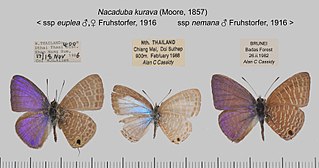Related Research Articles

Miletus symethus, the great brownie, is a small butterfly found in India that belongs to the lycaenids or blues family. The species was first described by Pieter Cramer in 1777.

Junonia hierta, the yellow pansy, is a species of nymphalid butterfly found in the Palaeotropics. It is usually seen in open scrub and grassland habitats.

Hypolimnas misippus, the Danaid eggfly, mimic, or diadem, is a widespread species of nymphalid butterfly. It is well known for polymorphism and mimicry. Males are blackish with distinctive white spots that are fringed in blue. Females are in multiple forms that include male-like forms while others closely resemble the toxic butterflies Danaus chrysippus and Danaus plexippus. They are found across Africa, Asia, and Australia. In the new world they are found in the West Indies, with strays in Central and North America.

Acytolepis puspa, the common hedge blue, is a small butterfly found in Cambodia, India, Myanmar, Thailand, Yunnan, Sri Lanka, Philippines, Borneo and New Guinea that belongs to the lycaenids or blues family. The species was first described by Thomas Horsfield in 1828.

Nacaduba kurava, the transparent six-line blue, is a Lycaenidae butterfly found in Asia and Australia. The species was first described by Frederic Moore in 1857.

The Indian fritillary is a species of butterfly of the nymphalid or brush-footed family. It is usually found from south and southeast Asia to Australia.
Dipriodonta is a monotypic genus of moths belonging to the subfamily Drepaninae and contains Dipriodonta sericea as only species, which is found in India.
Metathrinca tsugensis is a moth of the family Xyloryctidae. It is native to Japan, but is an introduced species in western Europe and Hawaii.
Pycnarmon mioswari is a moth in the family Crambidae. It was described by George Hamilton Kenrick in 1912. It is found in Papua New Guinea, where it has been recorded from Mioswar Island.
Stenorista fortunata is a moth in the family Crambidae. It was described by Schaus in 1912. It is found in Costa Rica.
Syllepte dinawa is a moth in the family Crambidae. It was described by George Hamilton Kenrick in 1912. It is found in Papua New Guinea.

Tyspanodes radiata is a moth in the family Crambidae. It was described by George Hamilton Kenrick in 1907. It is found on New Guinea.
Ambia fulvicolor is a moth in the family Crambidae. It was described by George Hampson in 1917 and it is found in New Guinea.
Oreta unilinea is a moth in the family Drepanidae. It was described by William Warren in 1899. It is found in New Guinea, where it is known from Papua and Roon Island.
Habrona papuata is a moth in the family Drepanidae. It is found in Papua and Papua New Guinea, where it has been recorded from mountainous areas.
Kurama mirabilis is a moth in the family Drepanidae. It was described by Arthur Gardiner Butler in 1879. It is found in Japan.
Exaeretia hildaella is a moth in the family Depressariidae. It was described by John Frederick Gates Clarke in 1941. It is found in North America, where it has been recorded from Alberta and the Northwest Territories.
Acrojana splendida is a moth in the family Eupterotidae. It was described by Rothschild in 1917. It is found in Ghana and Sierra Leone.
Striginiana nobilis is a moth in the family Eupterotidae. It was described by William Jacob Holland in 1893. It is found in Gabon.
Hypercallia chionastra is a moth in the family Depressariidae. It was described by Edward Meyrick in 1926. It is found in Colombia.
References
- ↑ Nuss, M.; et al. (2003–2014). "GlobIZ search". Global Information System on Pyraloidea. Retrieved July 15, 2014.
- ↑ A List of Moths of the Family Pyralidae collected by Felix B. Pratt and Charles B. Pratt in Dutch New Guinea in 1909-10; with Descriptions of new Species
| This Spilomelinae-related article is a stub. You can help Wikipedia by expanding it. |